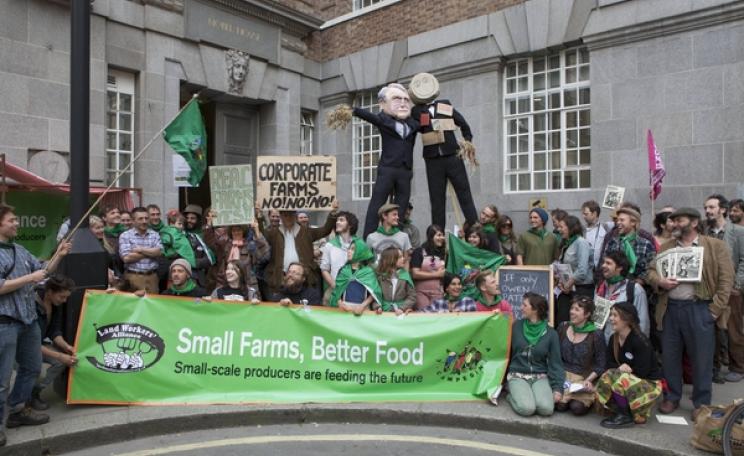Autumn: a season of abundance, when the fruits of the agricultural year are harvested, gathered and celebrated. September has traditionally been a time when our village halls, schools, churches, greens and pubs have hosted a wholesome display of prize courgettes, plump pumpkins, sacks of spuds and bushels of corn in a feast of thanksgiving. Today, however, the evocative harvest festival is just as likely to serve as an uncomfortable reminder of that new watchword ‘food insecurity’, rising prices and just how dislocated we have become from local,seasonal produce.
There are obviously exceptions. If you’re a celebrity chef or an ethical consumer you may well enjoy the warm glow of self-satisfaction that comes from joining the latest lifestyle crusade; you may even make some effort to buy seasonal and local produce, as and when it’s convenient. If, on the other hand, you happen to be a member of one of the 30 or so CSA schemes currently operating across the UK, quite simply you won’t be afforded the luxury of becoming dislocated from your food.
Community Supported Agriculture (CSA) is a term used loosely to describe a relatively new model of farming, pioneered in Japan, Germany and Switzerland during the 1960s, in which communities actively support the very farmers producing their food. That anyone would want to place culture over convenience may seem a far-fetched idea in a world where Tesco, Asda, Sainsbury’s and Morrisons control 72 per cent of UK food sales, but if recent rises in global food prices are anything to go by, convenience-culture now appears to be entering freefall.
Think outside the box-scheme
CSAs first came to our shores with the establishment of EarthShare box-scheme near Forres in Scotland, in 1994. Originally set up by a handful of committed growers as a non-profit company, the scheme currently supplies organic soft fruits and vegetables to as many as 180 local families every week from a 26-acre, gently sloping site overlooking the Moray Firth.
The scheme works by selling weekly veg box shares, which subscribers sign up to for a year at a time. The cost of a share varies depending on a number of factors, such as the size of the box and where it’s collected from, but most importantly, whether shareholders become actively involved ingrowing their food. Subscribers are encouraged from the very start to help with seasonal tasks such asweeding, soft-fruit picking and harvesting, in return for a reduction in their subscription fee.
Shares cover the cost of production and currently support five part-time members of staff and one full-time farmer, Nicky Cooper. Subscriber participation is the most essential component of the CSA model.
‘Without their help, production costs would be much, much higher and we just wouldn’t be able to farm organically,’ says Nicky. ‘More than three-quarters of our subscribers choose to help on the farm, and those who don’t are happy to support the part-time workers by paying a little bit extra.'
‘We currently have 170 subscribers who receive an equal share of everything that is harvested from the farm each week. If it’s a good year, everyone gets a bumper veg box; if one of the crops fails, however, we supply less of that crop than we planned. Our subscribers are much more aware of the seasons, the weather and the health of their crops. It’s about sharing the risks and rewards of farming.’
And it’s not just a greater awareness that CSA consumers benefit from. Through marketing locally, CSAs immediately reduce the number of links in the supply chain, cutting transport, retail and marketing costs and passing these cuts directly on to the consumer. As a result, CSAs are consistently able to compete with supermarket organics for both freshness and affordability, dispelling the myth that local organic food is available only to a select minority.
Many of the UK’s existing CSAs have taken the issue of affordability one step further by offering subsidised shares to those local residents who cannot afford the full share price. Swillington Organics, near Leeds, is currently piloting a scheme to allocate shares for its veg boxes to low-income families through local doctors’ surgeries.
‘Fresh, seasonal and organic food should not be a luxury enjoyed only by the middle-classes’, says Kirsten Glendinning, one of the scheme’s farmers. ‘It should be available to everyone as an alternative to intensively-farmed supermarket produce.’
While the majority of CSAs worldwide are built on the foundations of ecological agriculture, organic certification itself becomes unnecessary for a system in which consumers are immediately involved in the production of their own food. ‘In a typical CSA, organic standards are upheld regardless of certification due to the transparency and integrity of the system,’ says Glendinning. ‘The only time whencertifi cation should really be necessary is when selling surplus produce, which would otherwise go to waste, on to organic wholesalers.’
Security and independence
One of the greatest concerns for the conventional farmer in the UK today is securing a market that will provide a fair return for his or her produce. As a result, many farmers are dependent on both synthetic pesticides and fertilisers, to minimise the risk of crop losses and to boost productivity. Under a CSA agreement, however, where a local market is guaranteed in advance, this concern becomes largely redundant – and so too does a dependence on agrochemicals.
Direct marketing obviously also increases the farmer’s share of the food pound, which elsewhere has fallen dramatically. In the 1950s, UK farmers received on average 50p in every pound spent on food; today that fi gure has fallen to less than 8p. By contrast, farm wages typically account for the largest share of CSA subscription costs, with schemes such as Stroud Community Agriculture able to pay its farmers a living wage, compared to the £5.53 per hour average across the rest of the industry.
As a result of this mutual support, CSA farmers are given the security to reduce dependence on intensive agricultural systems, and the freedom to explore more localised and traditional farming practises. Importantly, the farmer also becomes valued once again as an essential part of the local community, providing not only fresh and affordable food but also more often than not regular well-paid employment.
Although the CSA model itself is relatively new here in the UK, the local-food movement on which it is based is well established. The unprecedented success of farmers’ markets, which have increased from just one in 1996 to more than 600 across the country today, is just one example of a willingness on the part of consumers to reconnect with their food. Between 2005 and 2006, organic sales made through direct marketing outlets alone increased by eight per cent to £136 million, demonstrating a dramatic rise in demand for ecologically produced, local food.
Separate to this shift in consumer awareness, however, and perhaps more immediate, are the looming challenges posed by the peak oil crisis. It is no coincidence that the sharpest rise in global food prices for a generation has hit the headlines in the same 12 months that crude oil has doubled from $75 to $140 a barrel. The UK has seen the price of staples such as bread, milk and eggs increase by an average of 11 per cent over that period as a direct result of the rising cost of oil accumulating along the supply chain.
A positive aspect to peak oil
Even the most rigid commentators recognise that this trend only strengthens the case for relocalisation of the food economy. With modern agriculture addicted to cheap oil at every stage of production, from mechanisation and a dependence on agrochemicals through to processing, packaging and transport, peak oil is now emerging as the catalyst, driving a fundamental shake-up of the ways in which we grow, process and consume our food.
It is in this arena of uncertainty that CSA now finds itself, not only catering for a shift in public awareness and demand, but also offering a timely solution to one of the most pressing challenges of the 21st century. Rob Hopkins, the architect of the increasingly infl uential Transition Towns movement, believes that the CSA model will be integral to building resilience in a post-peak oil society.
‘CSA essentially offers a unique model of farm security and community ownership at a time when agriculture is entering a period of unprecedented change,’ he says. ‘CSAs are central to the idea of reskilling our agricultural workforce for the coming transition to post- peak oil farming. As well as offering an achievable model of local and seasonal production they also provide an opportunity to re-engage our communities with their food.’
Interestingly, the uptake of CSAs in the UK has been relatively slow compared with its success in one of the world’s most oil- dependent regions: North America. The CSA concept was fi rst introduced to America from Switzerland in 1985, at a time when as many as 20,000 farmers every year were leaving the land as a result of intensification.The idea of supporting rural livelihoods in this way was immediately embraced by rural communities that had suffered at the hands of industrial agribusiness. Between 1985 and 1994, 600-plus CSAs had been established, and by 2002 there were 1,200 initiatives across the US and Canada supporting more than 100,000 families.
Above and beyond building resilience against oil dependency, however, CSAs also offer a more holistic approach to food production. The UK’s current model of agricultural effi ciency has largely restricted livestock production to the west of the country and cereals to the east, and is inherently unsustainable economically and environmentally. Localised, mixed farming of crops and animals, which share inputs and outputs such as manure, bedding straw and feed grain, makes a lot more sense than separate enterprises that rely on synthetic inputs.
One of the greatest assets of CSAs is how they are adapted to meet the specific needs of the communities they serve, typically reflecting local culture and what can sustainably be produced from the land available. As a result, no two schemes are likely to be the same. Dragon Orchard Cropsharers, near Ledbury, for example, produces local varieties of dessert, cooking and cider apples, as well as pears for a traditional Herefordshire market, while Stroud Community Agriculture specialise in biodynamically produced meat and vegetables to meet local demand.
Part of ‘sharing the risks and rewards’ also includes the amenity value of the land itself. Nearly all existing CSAs in the UK organise social events as an integral part of their service. Swillington Organics, for example, holds monthly activities, including bonfire nights, barbecues, open days and workshops.
‘It’s about building community,’ says Kirsten Glendinning. ‘Social events give our partners in the scheme the opportunity to meet and share an interest in where their food comes from. CSAs are as much about reconnecting us with the land as growing our food.’
Two-way street to success
Despite the rosy-glow of the good life that surrounds the concept, however, CSAs are in danger of being overlooked by even the most conscious of consumers. The term itself can, at best, conjure up responses of the ‘something to do with the Child Support Agency?’ kind, and at worst can appear too technical and hinder its promotion, particularly among farmers. A common misconception is that CSAs imply a one-way relationship of farmers seeking community support, whereas in reality it is usually the community seeking the support of their local farmers.
Last September, the Soil Association was one of nine organisations collectively awarded a £10 million Big Lottery Fund grant under the banner ‘Making Local Food Work’. Over the next fi ve years, the programme intends to help kick-start more than 650 local food initiatives, from CSAs to farmers’ markets, food co-ops and buying groups. Offering advice, workshops and online support, the Soil Association aims to provide practical training and support for individuals and groups interested in setting up CSAs in their own communities.
Amanda Daniel, information officer for the project, believes awareness is key in launching CSAs to a national audience. ‘It’s really a two- sided challenge: to raise consumer awareness on the one hand and to get farmers themselves interested as a viable business opportunity,’ she says. ‘We are really very excited about the potential of CSAs to offer a realistic and achievable model of sustainable local food production at a time consumers are most concerned about rising food and fuel prices.’
And this, in short, appears to be the defining factor. Consumer appetites have been shifting steadily over recent years towards both a reconnection with real food and an awareness of where it comes from. More recently this trend has been surpassed by the urgency with which we must now address our food supplies in increasingly uncertain times.
There is no doubt that to embrace the local food model on a national scale would represent the most dramatic revolution of our food supply since the second world war. What Community Supported Agriculture offers however, is a unique opportunity to capitalise on growing consumer momentum, with an immediate and effective alternative offering not only a reconnection with the land, but ultimately local food for all.
Ed Hamer is a freelance journalist specialising in agricultural globalisation issues. He also works on a small family farm in Devonshire.
For information about and support in starting a CSA in your community, visit:
www.soilassociation.org/csa
www.makinglocalfoodwork.co.uk
This article first appeared in the Ecologist September 2008







